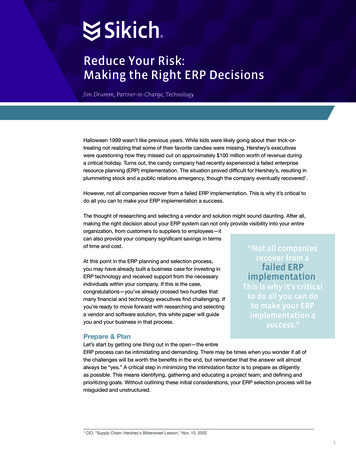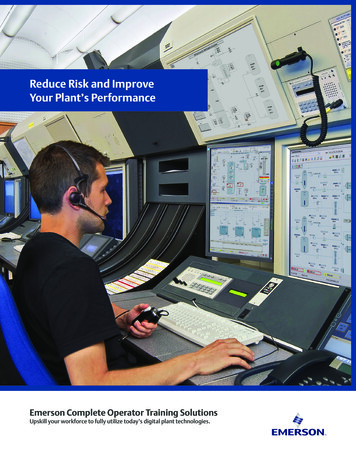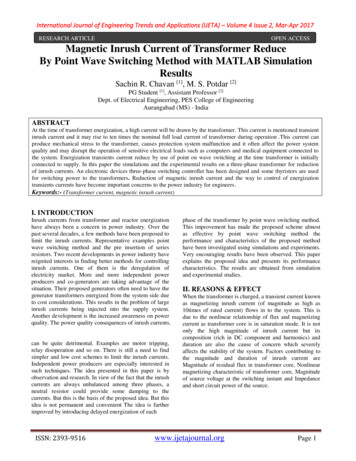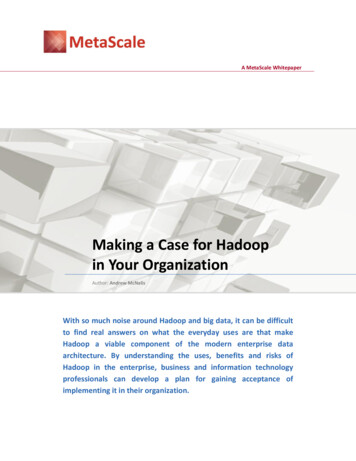
Transcription
Reduce Your Risk:Making the Right ERP DecisionsJim Drumm, Partner-in-Charge, TechnologyHalloween 1999 wasn’t like previous years. While kids were likely going about their trick-ortreating not realizing that some of their favorite candies were missing, Hershey’s executiveswere questioning how they missed out on approximately 100 million worth of revenue duringa critical holiday. Turns out, the candy company had recently experienced a failed enterpriseresource planning (ERP) implementation. The situation proved difficult for Hershey’s, resulting inplummeting stock and a public relations emergency, though the company eventually recovered1.However, not all companies recover from a failed ERP implementation. This is why it’s critical todo all you can to make your ERP implementation a success.The thought of researching and selecting a vendor and solution might sound daunting. After all,making the right decision about your ERP system can not only provide visibility into your entireorganization, from customers to suppliers to employees—itcan also provide your company significant savings in termsof time and cost.At this point in the ERP planning and selection process,you may have already built a business case for investing inERP technology and received support from the necessaryindividuals within your company. If this is the case,congratulations—you’ve already crossed two hurdles thatmany financial and technology executives find challenging. Ifyou’re ready to move forward with researching and selectinga vendor and software solution, this white paper will guideyou and your business in that process.Prepare & Plan“Not all companiesrecover from afailed ERPimplementation.This is why it's criticalto do all you can doto make your ERPimplementation asuccess."Let’s start by getting one thing out in the open—the entireERP process can be intimidating and demanding. There may be times when you wonder if all ofthe challenges will be worth the benefits in the end, but remember that the answer will almostalways be “yes.” A critical step in minimizing the intimidation factor is to prepare as diligentlyas possible. This means identifying, gathering and educating a project team; and defining andprioritizing goals. Without outlining these initial considerations, your ERP selection process will bemisguided and unstructured.1CIO, "Supply Chain: Hershey's Bittersweet Lesson," Nov. 15, 20021
Build an ERP Project TeamYou know that researching, selecting and implementing an ERP solution is a significantundertaking. Like any other assignment, the success of your ERP journey will much depend onthe ERP project team you put together. In addition to an ERP vendor, which we’ll discuss later inthis white paper, a strong ERP project team includes technology experts, company stakeholdersand executive management. As these groups are among those impacted greatly, offeringrepresentatives from each a seat at the ERP table allows them to bring experience and insights tothis important project.úú Technology experts are often individuals from the IT team who may be directly involvedwith the day-to-day operations of the ERP solution and/or will work closely with your vendorto actually implement the solution. These representatives may include VP of Technology, ITDirector or IT Manager.úú Company stakeholders, such as shareholders or partners, typically have a financial interest inthe ERP project. As these individuals are vested in your company, they look at the success (orfailure) of the ERP implementation as a direct impact on their bottom line.úú Executive management support and involvement is the most effective way to encourageothers within the company to get onboard with the new ERP solution. Whether you areimplementing your first ERP solution ever, or upgrading to keep pace with your company’sgrowth, change can be intimidating for some. Encouraging adoption from the top down canbring confidence to the solution’s end users.When selecting individuals for the groups above, it’s important to consider only those whodemonstrate full commitment to the project. Furthermore, these individuals should possess similarcharacteristics that will improve the project’s chances for success: strong communication skills;logical, critical and detail-oriented thinking; organizational skills; and the ability to influence others.These are the individuals who will “sell” this ERP solution to others in their groups.Define Your GoalsOnce your ERP project team is in place, you should begin the first team meeting by discussing,defining and prioritizing goals for the ERP implementation. For some, high-level goals mightinclude improving business growth rate or surpassing a specific number in terms of revenue.Financial growth is often the overarching goal of ERP implementations; however, there may bemore specific goals that drive that end result. Just like defining goals for smaller-scale projects,your ERP implementation goals should be ableRelevantTimely2
Take a manufacturing company, for example. A manufacturer can use ERP to improve efficiencywith internal processes and productivity, reduce waste and other costs, and improve qualityof materials produced. So, during the first ERP project team meeting, an agreed-upon goalmight sound something like, “Reduce monthly design costs by making fewer mistakes using astreamlined design process.” This goal clearly plays a part in the overarching goal of improvingfinancial performance, but is much more specific than, “Reduce costs.”The number of goals you define may be impacted by the ERP solution you ultimately select. SomeERP solutions are so massive that defining and achieving too many goals may be unrealistic.Regardless, it is better to have goals set prior to implementing, or even selecting, the ERPsolution, as it will help your team understand what is most important for this process.What to Consider During ERP Software SelectionYou know that implementing an ERP solution is a costly and time-consuming task. Did you knowthat an ERP implementation can take anywhere from a few months to more than a year fromconception to completion? This fact makes it even more critical that you do this right the first timeand avoid spending unnecessary time and money on a failed implementation. To ensure this, askyourself the following four questions when selecting an ERP solution:1.2.3.4.Does this ERP solution meet all of our functional requirements? Although this questionis a given for many companies in the early ERP stages, it may be one of the more importantquestions to ask. Looking back at the goals your ERP project team defined, determine if theERP solutions you are considering would help you meet the most critical goals.Does this ERP solution fit with our overall technology strategy? Selecting a solutionthat is unaligned with your overall technology strategy can create more complications. Forexample, it could uncover hidden costs, such as having to purchase additional servers orsecurity software required to support a specific ERP solution.What is the total cost of ownership? More than 50 percent of ERP implementations go overbudget. In order to determine the total cost of ownership, you should take into considerationmore than just the actual implementation. Many vendors include the implementationconsulting, software and support for one year in a quote. Ask for information regarding addon's, including how many user licenses you receive, whether or not training is included, if thequote includes customizations, etc. These factors, and many others, all play into the totalcost of ownership.Is this ERP vendor the right one for our company? There are so many ERP vendors outthere; it can be confusing to know where to start in selecting one. While it’s important thatpotential ERP vendors are established (you know they’ll be around for solution support), youshould also consider whether or not they have proven expertise in your industry.3
Research ERP Vendors & SoftwareSelecting the right ERP vendor is equally as important as selecting the right ERP softwaresolution. Yet as we mentioned above, just starting your ERP vendor search can be overwhelming.An effective place to start is researching potential vendors based on what you require in an ERPsoftware solution. Many companies already know which software solution they likely want toimplement before reaching out to potential vendors. While this can be problematic in that an ERPvendor can offer recommendations and advice based on decades of experience, it also may helpnarrow down a list of potential vendors.Typically, you’ll want to start with a long list of approximately eight to 12 potential ERP vendors.This will allow you to gather thorough information from a number of candidates, especially as itpertains to software- and industry-specific experience. A good rule of thumb is to select potentialvendors that have deep expertise in your industry, so they understand the challenges you faceand can provide suggestions for how to best use the ERP solution you choose.It is during this time when you will issue RFPs from these potential vendors to gain a high-leveloverview on the vendor and what they can offer your company. What you receive will likely varysignificantly. Some will inevitably provide you a higher price tag than others, and some will offeryou more customization opportunities than others. Review all of the RFPs with your ERP projectteam in order to determine with which you’d like to move forward into your short list of vendors.Some may be easily removed from the list simply based on budget.A short list of ERP vendors (approximately four to six candidates) is the most efficient way to drilldown even further and engage in serious conversations about your ERP requirements. At thispoint, it is appropriate to schedule and attend ERP demos, as well as ask for references.How to Get the Most Out of an ERP Software DemoWhen executed properly, a vendor demonstration can be the most vital part of comparing variousERP solutions that are on the market. As we all know, not selecting the right ERP solution can bedisastrous for your company. Vendor demos help mitigate that risk by walking you through theERP solutions that could work for your company, and helping you find the best possible fit. To dothis accurately; however, you should also consider the following tips on making the most ofthe demos:1.2.Communicate your ERP requirements to the vendor. This can be formally through the RFPprocess, or informally in an email, but your potential vendor should understand exactly whatyou need in an ERP solution.Schedule an on-site visit rather than a virtual demo. Even though on-site demos can takeup more time than you might like, in-person consulting can help a vendor better understandyour company and what you need in an ERP solution. Make the most of this time by offeringa facility tour and scheduling meetings with members of the ERP project team.4
3.4.Prepare your demo participants prior to the schedule demo date. To make the mostof your time, ensure that anyone participating in the demo has the agenda beforehand.Additionally, send the demo script to both participants and the vendor before the demo, sothat everyone is on the same page from start to finish.Don’t rush the demo. We’ve said it before and we’ll say it again—implementing an ERPsolution is costly, so you want to do it right the first time. Provide ample time to drill intospecific ERP solution features that could help you meet your ERP goals, and leave plenty oftime for questions and answers.Talk to ReferencesYou’ve created a short list of ERP vendors and have met for demonstrations with all of them.Now, you may have narrowed the playing field a bit more and are ready to learn what your finalcandidates’ references have to say. There are hundreds of questions you could ask a vendor’sreferences, but we have put together a list that will hit on some critical points, and may generateadditional questions of your own.úúúúúúúúúúOverall, are you happy with the vendor’s service and ERP solution you received?How long did the implementation process take, and did you finish on time?Did you finish on budget? If not, how much over budget were you?Who did you specifically work with from the vendor’s team?Did you have any problems with the vendor or the software, and if so, can youprovide specifics?úú Since the go-live, have you received ample support from the vendor?úú What lessons did you learn from the implementation process?Choose Your VendorBy this point, you have conducted a wealth of research on ERP solutions and potential vendors.You should be close to making a decision—but what if you’re not? This is one of the biggest andriskiest decisions a company can make; you need to be absolutely sure that what you selectis right. If you’re still lingering, it might be time to go back to your final candidates and gainreinforcement on some of your most critical questions:1.2.How will this solution help us make better business decisions and generate more revenue?What security protocols are used to protect data from both external threats and possibleuser error?3. What specific implementation tasks will your team handle?4. What will happen if there are functional and/or technical problems during the implementation?5. What will happen if we go over budget and/or the implementation runs long?6. Aside from ongoing support, what training resources are available to our team, and which areincluded in your proposal?7. What would you recommend if we outgrow this solution?8. What benefits would we see quickly using this solution?9. How long will it take to realize a return on this investment?10. Is there anything not included in your proposal that you would recommend for us? (Are thereany “hidden” costs?)5
What Not to DoWe’ve spent quite some time addressing what to do when planning for, researching and choosingan ERP software vendor, but what should you not d
Turns out, the candy company had recently experienced a failed enterprise resource planning (ERP) implementation. The situation proved difficult for Hershey’s, resulting in plummeting stock and a public relations emergency, though the company eventually recovered1. However, not all companies recover from a failed ERP implementation. This is why it’s critical to











